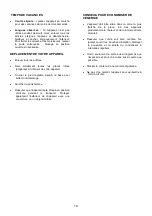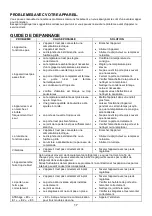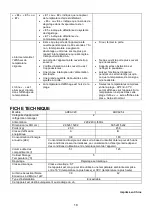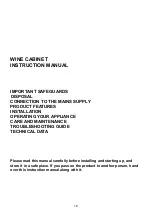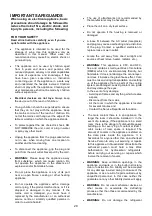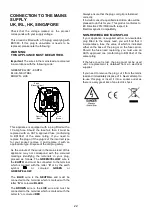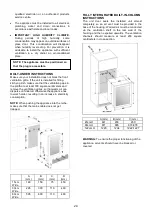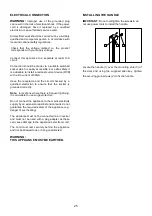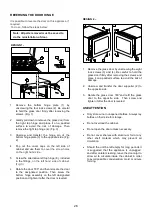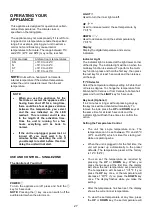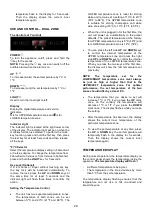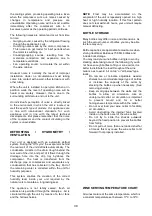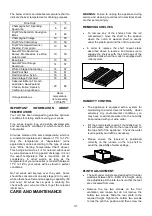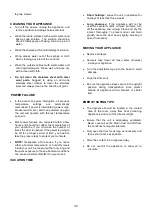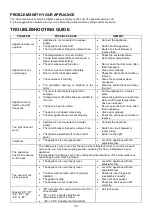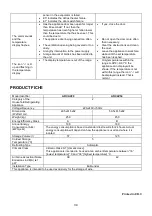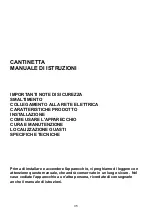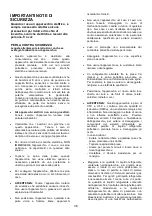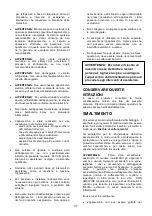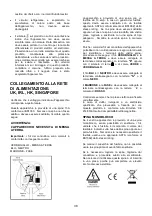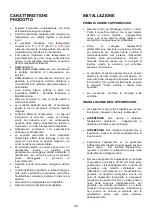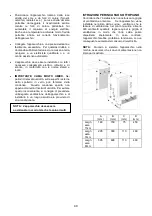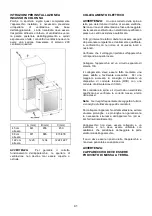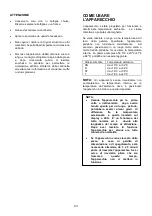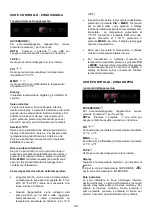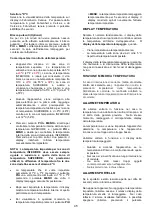
30
the cooling system, producing operating noise. Even
when the compressor cuts out, noises caused by
changes
in
temperature
and
pressure
are
unavoidable. Operating noise will be most audible
immediately after the compressor cuts in. It
becomes quieter as the operating period continues.
The following noises are normal and occur from time
to time:
- Gurgling sound, caused by the refrigerant flowing
through the appliance’s coils,
- Humming noise made by the motor compressor.
This noise can get louder for brief periods when
the motor is switching on.
- Cracking/popping sounds, resulting from the
materials contraction and expansion due to
temperature variations,
- Fan operating sound, to circulate the air within
the wine cabinet.
Unusual noise is normally the result of improper
installation. Under no circumstances must tubing
come into contact with a wall, other furniture or with
other tubing.
Where the unit is installed in open-plan kitchen or in
partition walls, the level of operating noise will be
heard more acutely. However, this is due to the
surrounding architecture and not to the unit.
An individua
l’s perception of noise is directly linked
to the environment in which the unit is located, as
well the specific type of models. Our appliances are
in line with international standards for such
appliance and in line with the latest technical
developments. But please remember that the noise
of the compressor and the coolant circulating in the
system is unavoidable.
DEFROSTING
/
HYGROMETRY
/
VENTILATION
Your unit is designed with an automatic defrost
system. During the
“Off-cycle” the evaporator behind
the rear wall of the unit defrosts automatically. The
condensate collects in the drain trough behind the
rear wall of the unit, and part of it flows through the
drainage hole into the drip tray by/above the
compressor. The heat is transferred from the
discharge pipe or compressor and evaporates any
condensation that has collected in the tray. Part of
the remaining water is collected within the unit for
humidity purposes.
This system enables the creation of the correct
humidity level inside your unit required by the
natural cork to maintain a long lasting seal.
The appliance is not totally sealed: fresh air
admission is permitted through the drainpipe. Air is
circulated through the unit by means of a fan / fans
and the hollow shelves.
NOTE:
Frost may be accumulated on the
evaporator if the unit is repeatedly opened in a high
heat or high humidity location. If this frost pattern
does not clear within 24 hours, your unit will require
manual defrosting.
BOTTLE STORAGE
Many bottles may differ in size and dimensions. As
such the actual number of bottles you may be able
to store may vary.
Bottle capacities are approximate maximums when
storing traditional Bordeaux 750 ML bottles and
include bulk storage.
You may load your wine bottles in single row or by
stacking while taking note of the following: if you do
not have enough bottles to fill your wine cellar, it is
better to distribute the load throughout the wine
cellar so as to avoid “all on top” or “all below” type
loads.
-
Do remove or relocate adjustable wooden
shelves to accommodate larger type of bottles
or increase the capacity of the cellar by
stacking the bottles up when necessary. (See
removing shelves)
-
Keep small gaps between the walls and the
bottles to allow air circulation. Like an
underground cellar air circulation is important
to
prevent
mould
and
for
a
better
homogeneous temperature within the cellar.
-
Do not over load your wine cellar to facilitate
air circulation.
-
Avoid obstructing the internal fans (located
inside on the back panel of the wine cellar).
-
Do not try to slide the shelves outwards
beyond the fixed position to prevent the bottles
from falling.
-
Do not pull out more than one loaded shelf at
a time as this may cause the wine cellar to tilt
forward if not properly installed.
WINE SERVING TEMPERATURE CHART
All wines mature at the same temperature, which is
a constant temperature set between 11ºC to 14ºC.

